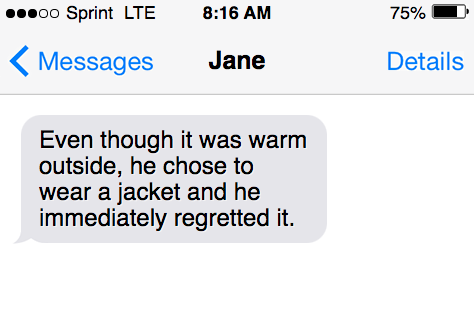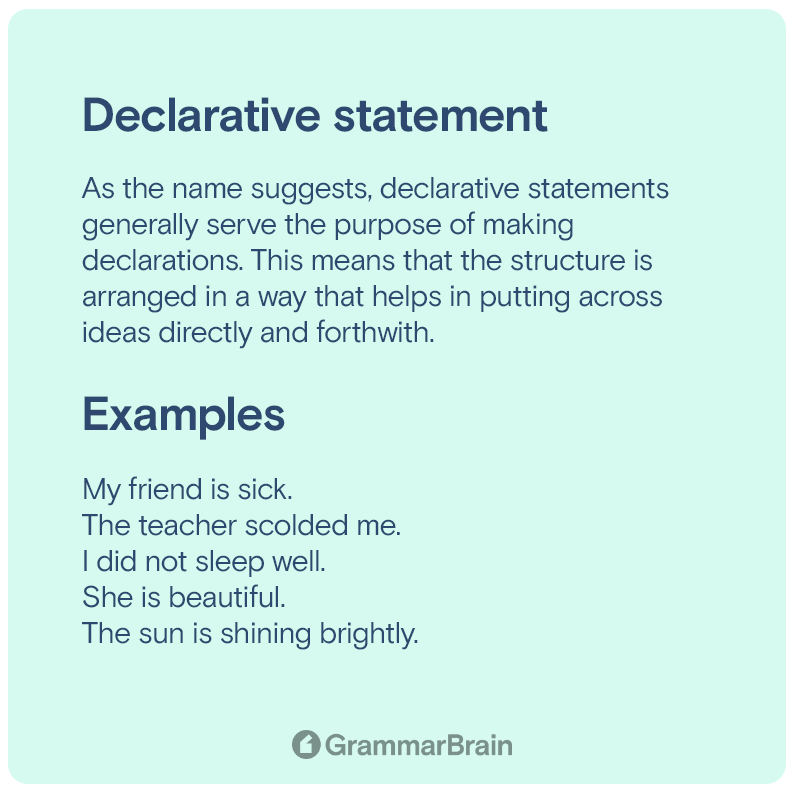Linguistics and syntax comprise an amalgamation of structures that help us comprehend the English language. One of the essential aspects is sentence structure and type. Often, the lines between different sentence types tend to get blurry.
Making a clear distinction of what sets them apart, and understanding their characteristics through the usage of examples is a helpful step towards gaining a comprehensive understanding of them.
Among the various types, a declarative statement often finds itself at the forefront, which has been discussed below.
What is a declarative statement and sentence?
As the name suggests, declarative statements generally serve the purpose of making declarations. This means that the structure is arranged in a way that helps in putting across ideas directly and forthwith.
They often tend to be informative in nature since they are purely stated for the objective of announcing something.
If you ever find yourself on the brink of a conundrum, then assessing your statement’s contents can help you determine whether it is a declarative statement.

If you are using the language to convey ideas, facts, opinions, or even to explain anything, then a declaration statement comes into play. Declarative sentences also follow a clear structure – one that requires a subject as well as a predicate.
While the subject is the noun performing the predicate strings together the sentence by facilitating the action.
When combined, they can be effectively used to put forth ideas through the usage of declarative sentences.

Types of declarative sentences
The subject and predicate, which together constitute a part of the declarative sentence, are known as independent clauses. While one independent clause is an essential requirement for any sentence to be categorized as declarative, the sentence may also have more than one.
Depending on these criteria, declarative sentences are further broken down into sub-parts.
They are:
- Simple sentences
- Compound sentences
- Complex sentences
- Compound-complex sentences
Simple sentence
In its most skeletal form, a simple sentence comprises just one independent clause. This means that such sentence structures are devoid of any nuances and simply aim to convey the message in the most direct manner possible. Most informal language consists of simple sentences.
They are brief yet effective at getting the message across, which makes them a widely popular type of declarative sentences. Generally, a simple sentence does not require much brainstorming. It follows a very skeletal framework.

Examples
A few examples that can better help you understand simple sentences are –
- My friend is sick.
- The teacher scolded me.
- I did not sleep well.
- She is beautiful.
- The sun is shining brightly.
Compound sentence
A compound sentence moves up a notch regarding the quantum of independent clauses. It consists of two clauses, which are often joined together through coordinating clauses. Examples of coordinating clauses include ‘and,’ ‘but,’ ‘for,’ ‘nor,’ ‘yet,’ ‘but,’ ‘or’ and ‘so.’
To connect them efficiently, you may also use commas or semicolons. If you spot a sentence with two subjects and predicaments, they can be categorized as compound sentences.
Examples
Some examples of compound sentences include –
- My mother wanted to skiing but my father wanted to stay in.
- The teacher was in high spirits, but the students were quite exhausted.
- I like to cook, and my friend loves to eat new dishes.
- The artist could not make an appearance, so he made his assistant visit us.
- She wanted to work through college, but her father was willing to pay for it himself.
Complex sentence
A sentence is called a complex sentence when it consists of one independent clause along with several different subordinate clauses. While their order does not play a role in the categorization, it helps to separate them through the use of commas for better comprehensibility.
The structure for such sentences often tends to get convoluted. In such cases, it helps to isolate the clauses and assess whether they are independent or subordinate.

The nature of the subordinate clause has led to the further categorization of complex sentences into three parts
- Where the subordinate clause behaves as an adverb.
- Where the subordinate clause behaves as an adjective.
- Where the subordinate clause behaves as a noun.
Examples
Examples that better help in distinguishing complex sentences are as follows:
- During the monsoon season, I opt for long boots.
- Despite being a gifted student, she failed her exams due to academic stress.
- While she is a passionate singer, she will not pursue music as a career.
- Even though she worked hard, she could not win the race.
- By the time we were done, their team had already completed the task.
Compound-complex sentence
A compound-complex sentence follows a distinct nature of containing more than one independent clause, along with multiple subordinate clauses.
They tend to be longer and contain heavier subject matter. Such sentences find their application in more nuanced and embellished writing.
Examples
Examples of complex-compound sentences are:
- Even though it was warm outside, he chose to wear a jacket and he immediately regretted it.
- Someday in the future, she wants to tour the world but for now she will have to focus on her studies.
- Although they were good friends, they drifted apart because she moved to Canada and he went to China.
Word orders in declarative sentences
Word order refers to the structure of succession maintained by the subject, the verb, and the object of the sentence. Declarative sentences follow a fairly definitive word order, which is – the subject, followed by the verb, and then the supporting object.
While connective words and phrases can be added at the end or beginning, the basic framework requires the predicate to follow the subject. Sometimes, there may not be an object. In such a case, only the subject and predicate will suffice.
Examples
- The policeman is walking towards the park.
Here, the policeman forms the subject; walking serves as the verb, and the park acts as the object.
- The sky is cloudy today.
Again, here the sky is the object, and cloudy is the predicate.
Difference between declarative sentences and interrogative
An interrogative sentence is used to pose a question. On the other hand, declarative sentences are statements, often factual or opinionated. They differ not only in terms of end objective but also in word order and punctuation.
In an interrogative sentence, the word order is – verb, succeeded by the subject and in turn, the object. Moreover, they also have a question mark at the end, whereas a declarative sentence only ends with a period.
Examples
1. The sentence ‘have you finished eating?’ is an interrogative sentence, whereas ‘I had a sandwich for lunch’ is a declarative sentence.
Difference between declarative sentences and exclamatory sentences
The most noticeable difference between a declarative sentence and an exclamatory sentence is the punctuation. An exclamatory one invariably consists of an exclamation point in the end, since it conveys some form of excitement or urgency. Declarative statements convey opinions or facts, whereas exclamatory sentences are based on sudden occurrences.
Examples
1. ‘We won the race!’ is an exclamatory sentence, while ‘the race was won by the blue team’ is a declarative statement.
Difference between declarative sentences and imperative sentences
An imperative sentence is used to relay commands or make a request for something. While the former may be used in any punctuation, they generally make use of an exclamation mark for better effect. Unlike their declarative counterpart, imperative statements also do not constitute of a subject, since the subject is assumed to be the speaker.
Examples
1. The statement ‘pick up the toys on the floor!’ is an imperative sentence, whereas ‘he picked the toys off the floor’ is a declarative sentence.
Examples of declarative sentences in literature
The world of literature is full of a plethora of prominent declarative sentences. These have gripped the hearts of readers for generations altogether, and a few examples of the same are:
- “It is a truth universally that a single man in possession of a good fortune must be in want of a wife.” – Pride and Prejudice by Louisa May Alcott.
- “It was the best of times, it was the worst of times.” – A Tale of Two Cities by Charles Dickens.
- “Shoot all the blue jays you want, if you can hit em, but remember that it’s a sin To Kill a Mockingbird.” – To Kill a Mockingbird by Harper Lee.
What is a declarative thesis statement?
A declarative thesis statement is a statement used to convey the stance adopted through the entirety of the thesis. This is used to give the reader a glimpse into the side that the thesis will explore and forms the basis for any bias being formed. Such a statement needs to be concise and effective in conveying the thesis’s objective. Based on this, the groundwork for the rest of the thesis is laid.
Examples
- The debilitating effects of poverty on developing economies.
- The cascading effect of hyperinflation.
Sources
- 1. What are declarative sentences?
- 2. Complex sentences
- 3. What is a compound sentence?
- 4. Types of declarative sentences
- 5. Interrogative vs declarative sentences
- 6. About exclamatory sentences
- 7. Difference between imperative and declarative sentences
- 8. Declarative thesis statements
Inside this article
Fact checked:
Content is rigorously reviewed by a team of qualified and experienced fact checkers. Fact checkers review articles for factual accuracy, relevance, and timeliness. Learn more.
Core lessons
Glossary
- Abstract Noun
- Accusative Case
- Anecdote
- Antonym
- Active Sentence
- Adverb
- Adjective
- Allegory
- Alliteration
- Adjective Clause
- Adjective Phrase
- Ampersand
- Anastrophe
- Adverbial Clause
- Appositive Phrase
- Clause
- Compound Adjective
- Complex Sentence
- Compound Words
- Compound Predicate
- Common Noun
- Comparative Adjective
- Comparative and Superlative
- Compound Noun
- Compound Subject
- Compound Sentence
- Copular Verb
- Collective Noun
- Colloquialism
- Conciseness
- Consonance
- Conditional
- Concrete Noun
- Conjunction
- Conjugation
- Conditional Sentence
- Comma Splice
- Correlative Conjunction
- Coordinating Conjunction
- Coordinate Adjective
- Cumulative Adjective
- Dative Case
- Determiner
- Declarative Sentence
- Declarative Statement
- Direct Object Pronoun
- Direct Object
- Diction
- Diphthong
- Dangling Modifier
- Demonstrative Pronoun
- Demonstrative Adjective
- Direct Characterization
- Definite Article
- Doublespeak
- False Dilemma Fallacy
- Future Perfect Progressive
- Future Simple
- Future Perfect Continuous
- Future Perfect
- First Conditional
- Irregular Adjective
- Irregular Verb
- Imperative Sentence
- Indefinite Article
- Intransitive Verb
- Introductory Phrase
- Indefinite Pronoun
- Indirect Characterization
- Interrogative Sentence
- Intensive Pronoun
- Inanimate Object
- Indefinite Tense
- Infinitive Phrase
- Interjection
- Intensifier
- Infinitive
- Indicative Mood
- Participle
- Parallelism
- Prepositional Phrase
- Past Simple Tense
- Past Continuous Tense
- Past Perfect Tense
- Past Progressive Tense
- Present Simple Tense
- Present Perfect Tense
- Personal Pronoun
- Personification
- Persuasive Writing
- Parallel Structure
- Phrasal Verb
- Predicate Adjective
- Predicate Nominative
- Phonetic Language
- Plural Noun
- Punctuation
- Punctuation Marks
- Preposition
- Preposition of Place
- Parts of Speech
- Possessive Adjective
- Possessive Determiner
- Possessive Case
- Possessive Noun
- Proper Adjective
- Proper Noun
- Present Participle
- Prefix
- Predicate



